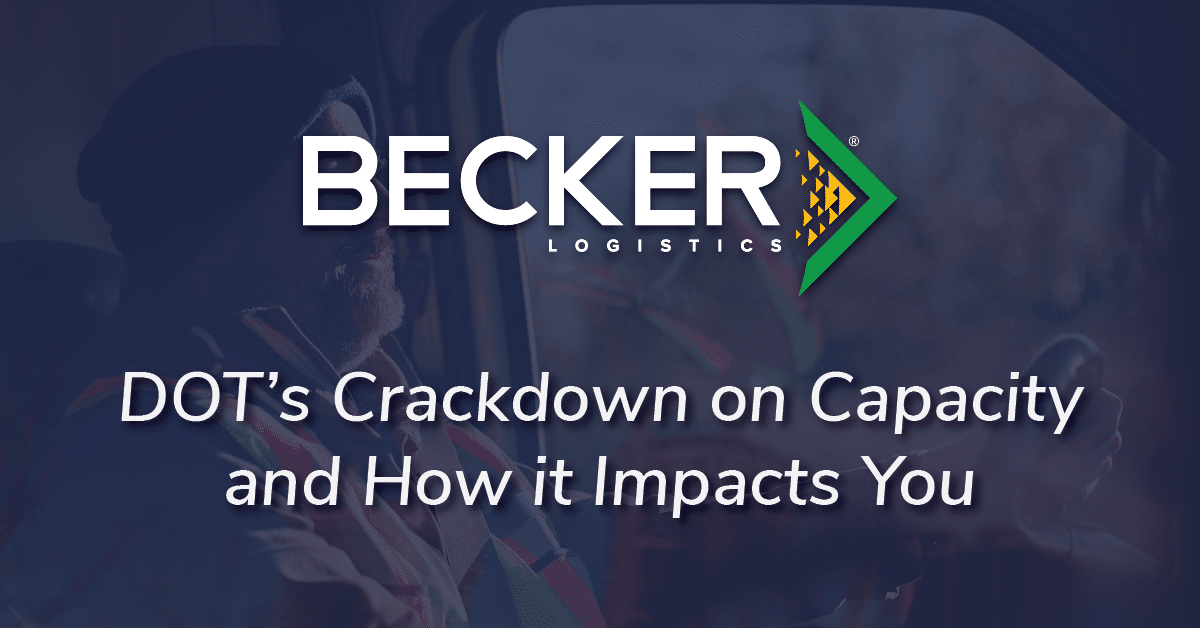Recently, the U.S. freight landscape has been shaken by a sweeping regulatory overhaul: the Department of Transportation (DOT) and FMCSA (Federal Motor Carrier Safety Administration) are enforcing strict new rules on non‑domiciled CDLs, potentially forcing close to 200,000 drivers out of the market.
For shippers, carriers, and supply chain managers, the implications are profound: fewer trucks, lengthening lead times, rate volatility, and greater risk in capacity planning. Here’s what’s happening and what you should be doing about it.
What’s Changing: The New Rules & Enforcement
A Nationwide Audit
FMCSA recently initiated a nationwide audit of how states issue non‑domiciled CDLs and CLPs (commercial learner’s permits). The audit found systemic failures in many State Driver Licensing Agencies (SDLAs), from software errors to procedural gaps and poor oversight.
Some states were issuing CDLs valid well beyond the holder’s lawful presence in the U.S., or to individuals who lacked proper immigration authorization. In California, for example, auditors determined that over 25% of non‑domiciled CDLs reviewed were improperly issued.
The Emergency Interim Final Rule Takes Effect
On September 29, 2025, FMCSA’s emergency interim final rule (IFR) became effective immediately. Key changes include:
- States can no longer issue non‑domiciled CDLs or CLPs to noncitizens based solely on an employment authorization (EAD) unless that employment falls under certain visa categories.
- Applicants must present unexpired foreign passports, I‑94 / I‑94A forms, and be verified via SAVE (Systematic Alien Verification for Entitlements) each time they apply, renew, or upgrade.
- Licenses must expire no later than the employment authorization or in one year, whichever is sooner.
- Renewals must be done in person, and SDLAs must downgrade or revoke non‑compliant licenses if eligibility is lost.
- States must pause issuance of non‑domiciled CDLs until they can comply with these stricter requirements.
States found out of compliance risk losing federal highway funding, being decertified, or facing other sanctions.
What the Market Is Experiencing Now
Driver Losses Could Approach 200K
FMCSA estimates that 194,000 non‑domiciled CDL holders and 20,000 CLP holders may no longer qualify under the new rules. That’s a significant slice of the driver pool, especially in regions and segments heavily reliant on immigrant labor.
Because renewals must now go through stricter verification or be disqualified, many existing drivers may opt not to renew or simply lose eligibility over time.
Spot Rates Are Rising
Despite generally soft freight demand in some lanes, spot market rates are creeping upward. Capacity is tightening before demand fully rebounds.
Shippers are reporting increased difficulty locking in last‑mile service, bookings being pushed out, and more aggressive rate negotiations from carriers with open trucks.
Waves of Pressure on Small Carriers & Operators
Many small owner‑operators, especially those built around non‑domiciled drivers, are already under pressure. Some may go out of business, be absorbed by larger competitors, or shrink capacity.
In niche or specialized segments (agriculture, regional hauls, port drayage), where relationships, language skills, and local knowledge matter, replacing missing capacity is even tougher.
Heightened Regulatory & Compliance Risk
FMCSA oversight is increasing. Expect more roadside inspections, audits of driver credentials, and stricter enforcement of English proficiency, records, and eligibility documentation. Drivers failing to meet English proficiency (already required under regulation) may be placed out of service.
What Shippers Should Do Right Now
Revise Your Capacity Strategy Immediately
Don’t wait for the supply pinch, begin securing reliable carriers now. Implement tiered commitments and longer lead times in lanes where risk is high. Use your contract rates as cushions to absorb spikes in the spot market.
Audit Your Carrier Base
Vet each carrier for compliance readiness. Ask for documentation, CDL vetting practices, driver renewals, and audit trails. Shift business toward carriers with robust processes and fewer vulnerabilities.
Scenario Forecasting & Contingency Modeling
Build “stress test” models: what if 10% of your drivers’ routes lose capacity? 20%? What price shock would you absorb? Use those models to push for binding capacity contracts or service guarantees where possible.
Partner with a Tech Driven 3PL
Working with 3PLs that have broad, vetted carrier networks, track‑and‑trace systems, and proactive management can ease the burden. Their ability to shift loads, cover gaps, and absorb volatility becomes a competitive advantage.
What Carriers & Drivers Should Prepare
- Audit your CDL and CLP issuance & renewals immediately against the new rules. Relying solely on an EAD will no longer suffice.
- Shift to compliant visa categories if possible (H‑2A, H‑2B, E‑2) for noncitizen drivers.
- Improve documentation systems and align with SAVE and federal verification tools.
- Promote your compliance as a competitive advantage, shippers will prefer providers with lower risk.
- Plan ahead for audits: maintain records, conductor internal reviews, and be proactive.

What to Expect in 12–24 Months
- Some market participants warn of a return to 2021‑style conditions: tight capacity, steep rates, and service challenges.
- Freight volumes may eventually rebound or shift, but capacity won’t bounce back quickly; driver training, recruitment, and infrastructure gaps take time.
- Regulators may refine or adjust rules based on industry feedback, legal challenges, or political pressure, but until then, enforcement is the priority.
- Shippers who invested early, strengthened partnerships, and modeled volatility will fare better than those caught flat-footed.
Next Steps
DOT’s crackdown on non‑domiciled CDLs is more than a regulatory shift, it’s a restructure of the U.S. trucking capacity landscape. The reverberations will affect rates, service reliability, and how shippers must plan.
At Becker Logistics, we’re actively monitoring changes, vetting carriers for compliance, and preparing contingency frameworks to protect your supply chain. Let us help you stress-test your capacity strategy now, lock in dependable partnerships, and navigate this transition cleanly.




